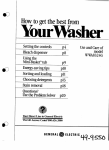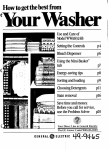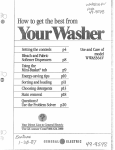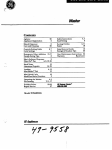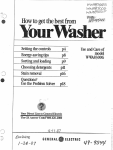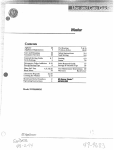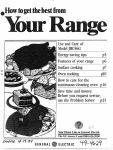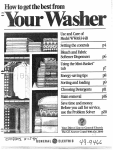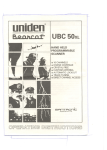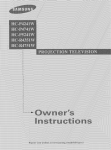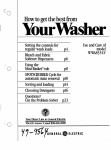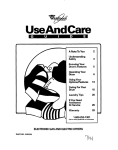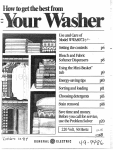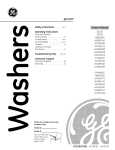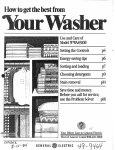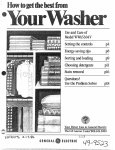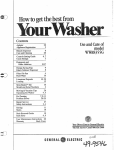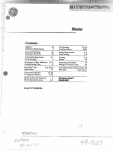Download GE WWA8480G User's Manual
Transcript
togetthebestfrom
w
use
andcat!of’
A8480G
Mode~W
SemgtheControk
p4i
BleachandFabtic
Sofiener
Dispensers
pfi!l
Ushgthe Mhi-Baskertub -j$)
Ener~-saving
tips
plo
SortingandIoadhg
—
Choosing
Detergen@
ppi
p18
andmoney
youcallfor
Sewice,
Before
usetheProblem
Solver p20
~~V~ the
Your Direct Line’ to GeneralElectric
The GEAnswercenter800.626.2ooo
helpyfwui
*e
6$
si%feiyhwuctions , . . . . .. ’..3”4
your
How moperate
\y~&~~
, ‘.~.........+*....
4-5
●
Ccmtds settingguidefor
different fab~icsand loads. . . . .6-7
and
H(MV10 use 13k%idl
fabric softenerdispensers . . . . ...8
Flow
to use Mini-13asketT~f
--.
-
tub. ..: . . . ..*-. . ..*. *.*. .*”””~
Ener’gy-savimgtips. =. . . ..... . **10
Read-thisuse$MBdi
care
Book C%refuuy
writed’fn%m
the modei Ztmil
Itwillhelp you operate and
maintain your new washer
properly.
Keep it handy for answers to your
questions.
If you don’t understand
something or need more
help...Call, toll free:
The GE Answer center~~
800.626.2000
You’llfind them on a label on the
lower left side near the front.
These numbers are also on the
Consumer Product Ownership
RegistrationCard that came with
your washer. Before sending in
this card, pleasewrite these
numbers here:
Consumerinformation
wrvim
Cod. smting means bette~
~ or write (includeyour phone
washings.. . . . . . . . . . . . . . ~. . ....il”
~
number):
R pays to check and
“.
., . ‘ 11
Consumer Affairs
pre-tr’eat. . . . . . . . . . . .* ***..** ,
General Electric Company
.,‘
Appliance Park
Louisville,KY 40225
H you received a damaged
Wkit k the-best size-load- -‘ -, .
washer, immediatelycontact the
Ofclothes.........”..?”:’”’”
‘~
dealer (or builder) that sold you
the washer.
ccmkkx in
“ - ,..
Factim to
save time and money. .
Sekxtiond?Ckte’rgm
~
mdsoap
. ...’.’. ...-”””.” ”””” ””~~ “ before you call for service
Check the Problem Solver(pages
Themul{d
‘
‘
-“’-’ 20-25).
It lists minor causesof
Cmtirwd-us$l
d
“ :,
‘
“
operating problems that you can
Cadxmatedetwgents . . . . . . .-M
correct yourself. It could save you
an
unnecessaryservicecall.
How muchdete<gent& soap - ~
shouldyouuse- . . .. ’.. ..el. ~. .15
How to use detergent
or soap . . ; . . . . . . . . . . . . ... . . . . i5 Had water—do ym
have it . . . ..** ...a”*. . ..a” *...16
CMxxfkituldr
yproducts
... ..
How to remove stains. . . . . .M-W
●
●
●
●
said numbers,
Model No.
Serial No.
Use these numbers in any
correspondenceor servicecalls
concerningyour washer.
To obtain Hispanic version of
this book, call
The ~~ Answer CenterTk4
[email protected]
consumer information service.
Toll-free.
Para obtener la versibnen
espailolde este manual,
Uamegratis a
The GE Answer Center,
serviciode infcwmacibn
para el conswnicior,
teEfono 800.626.2000.
..m
All washinginstruction terms in this book conform to the Care Labeling
Rule establishedby the Federal Trade Commission,.lanuary 1984.
Important
safety
Instmctions–sAvE
THNSE Instructions
Read81]instructions before’using
this appliance
.&?&A
w%+
WARNING—When using this
appliance,alwaysexercisebasic
safetyprecautions, includingthe
following:
~ Use this appliance only for its
intended purpose as describedin
this Use and Care Book.
@This washer must be propedy
insfdkd and ilcmtwi in
accordance with the Installation
Instructions before it is used. If
you did not receivean Installation
Instructionssheet with your
washer,you can obtain one by
contactingthe servicelocation
nearestyou.
- Properly ground to conform
with all governingcodes
and ordinances.
- Install or store where it willnot
be exposedto temperatures
below freezingor exposedto
the weather.
- Connectto a properly rated,
protected and sizedpowersupplycircuitto avoid electrical
overload.
- Connectto adequate plumbing
and drain facilitiesas described
in the Installation Instructions.
~ Turn off water faucets when the
washeris not in use to relieve
pressureon hoses and valves,and
to minimizeleakageif a hose or
valveshould break or rupture.
@When disconnectingthis
appliancepull by the plug rather
than the cord to avoid damage to
the cord or junction of cord and
plug. Make sure that the cord is
locatedso that it willnot be
steppedon, tripped over or
otherwisesubjected to damage
or stress.
~ We strongly recommend that
any servicingbe performed by
a qualifiedindividual.
* The wiringdiagram for this
machineis Iocated insidethe
control panel.
m minimize
W? possibility
ofinjury:
@Neverreach into the washer
whileit is moving.Before loading,
unloadingor adding clothes,push
@Do not mix chlorinebleachwith in the CycleSelectorKnob to
ammonia or acids such as vinegar “STOP” position, then wait until
and/or rust remover.Mixingcan
the machinehas completely
produce a toxicgas whichmay
stopped before openingthe lid.
cause death.
@Closesupervisionis necessary
@Do not wash or dry articlesthat
if this applianceis used by or near
have been cleanedin, washedin,
children. Do not allowchildrento
soaked in, or spotted with
play inside,on, or with this applicombustibleor explosive
ance or any discardedappliance.
substances(such as gasoline,
Disposeof discardedappliances
degreasers,dry-cleaningsolvents, and shippingor packingmaterials
kerosene, etc.) whichmay giveoff properly.Beforediscardinga
vapors that could igniteor
washer or removingfrom service,
explode.
removethe washerlid.
Do not add these substancesto the @Keepall laundry aids (such as
wash water.
detergents,bleaches,fabric sofDo not use these substances
teners, etc.) out of the reach of
around your washer and/or dryer children,preferablyin a locked
during operation.
cabinet. Observeall warningson
$ HYDROGEN GAS is produced containerlabelsto avoid personal
by the chemicalaction withinyour injury.
water heater and the gas can
@I
Keepthe area around and underaccumulatein the water heater
neath your appliancesfree from
and/or water pipes if hot water has the accumulationof combustible
materials, such as lint, paper, rags,
not been used for a period of two
weeksor longer.HYDROGEN
chemicals,etc.
GAS CAN BE EXPLOSIVE
@Keep the floor around your
UNDER THESE CIRCUMappliancesclean and dry to reduce
STANCES. So to preventthe
the possibilityof slipping.
possibilityof damage or injury, if
@To minimizethe possibilityof
you have not used hot water for
electricshock,
unplug this applitwo weeksor more, or moveinto
ance
from
the
power-supplybefore
a residencein whichthe hot water
systemmay not have been used for attempting any maintenanceor
cleaning(exceptthe removal and
some time, turn on all hot water
cleaningof the lint filter). NOTE:
faucets and allowthem to run for
Turningthe CycleSelectorKnob to
severalminutesbefore usingany
an OFF position does NOT diselectricalappliancewhichis conconnectthe appliancefrom the
nected to the hot water system.
power-supply.
This willallow any hydrogengas
to escape. Of course, sincethe gas
is flammable, do not smoke or use
an open flame or applianceduring
this process.
3
+s@j@
&jfgfetiyInstmctiolls(comti~u~d)
JQ+-J-Q;
%==,l.
%
@
Do
.
Carl HxhJce wash and spin action and prevent
with
ccmtroh. ~Thehnchy-(?1003ss
this
tqqmmce
if the flame retardancy of fabrics. To completionof the cycle,
3301m.mper
@DQ nt’jt Qpmte
~~~~&m&&d, Hlalfl!nctioning,
partially disassembled,or has
missing03broken parts, including
a damaged cord or plug.
= Do MMwash fibergkxssarticlesin
your washer,N&3irritation could
resuit from the remainingparticles
that may be picked up by clothing
duling subsequentwasheruse.
How’
~ Do not changeFABRICCARE
SELECTION whilewasheris
operating. If a changein speed.is
desired, push in CycleSelector
Knob to “STOP” position and
wait for washerto stop. Then
make new FABRIC CARE
SELECTION and PUBout Cycle
SelectorKnob to restart
—
-.
FULL
KNOE
TO
START
-FWS+I
TO
SW
c
? f?
COLORFAST
cOT 70++s
c1
.-.
your Clotheswasher
to operate
q
avoid such a result, the Garment
Manufacturers’Care Labels
should bc followedvmycarefully.
~Neverclimbcmor stand on the
washertop.
For Wwber operation
~ Do not leavewasher lid up
during cycle.This willstop the
~even
Qyclg-
Programmed
Wa8her
Regular
—------
C)lcles
wJth_~ini.Wesh
TV’
Fabric
Cere
Selections
‘
Jm
p2$!!!
L
,~;&~’’’”&”&
.:..
b(ll){-i
‘%:6’;..,%1,
wOWENS
:
m—
❑~’
:
Extra Cleaning
Cycles
‘2;;’’4’’::,
HEAvY
SOIL
MOOSRN
FABRICS LARQE
H
a~
~~ a
sorting
and Loading
Set the controls. See the Controls SettingGuide on pages6-7.
n Selectal?abric Care program.
~ Sort clothescarefullyby fabric
type, weight,color and amount of
I Autmaticdly Programmed
I
soilaccordingto instructionson
Rinse
Spin
Wash
Wash
page 11.
Fabric Care Selections
Temp.
Temp.
Speed
Speed
@RemoveFilter-l?lo@pan and
Normal
Normal
Hot
Cold
Cottons Colorfast
Mini-BasketT~tub. The underside ,
Warm
Cold
Cottons Non. Colorfast
Normal
Normal
of the lid is a good placeto put the
Normal
Cold
Gentle
Warm
Penn Press
pan whileloading or unloading
Gentle
Cold
Knits or Delicates
Gentle
VVarm
clothes.
Gentle
Warm
Cold
Sib or Woolens
Normal
Do not use Mirii-13askettub when
washingregular loads. You’llfind
completedetails on how and when
to use the Mini-Baskettub
cmpage 9.
~ Load clothesinto the wash
basket beingcareful not to overload. CIothesshould be belowthe
~~~~~~i~g rj~g, see page 12for
more loading informatiorl.
@!Position Filter-1% pan on agitator and NMmeasured amount of
detergent. Seepages 13through 17
for kifmmatim cmdetergentsand
Othtr ktunclryadditives.
B SelectWater Level.
SMALL: Washeris lessthan M
fulI of cIothes.
MEDIUM: Between Y3and ?ZZ
full.
LARGE: Between % and ?4 full.
EXTRA LARGE: Over ?4 full.
MINI-BASKET:Seepage9.
If you wish to increaselevelafter
you’vemade a selection,tur~ knob
to “RESET” and selectnew level.
n SeIectOptions.
Use this control if you wishto
changethe water temperatures that
are automaticallyprogrammed by
the Fabric Care selectionscontrol.
NORMAL—Leavesthe temperatures as programmed.
COLD WAN-I-l?rovides cold
wash am! rinsewater iriall cycles.
WARMRN3E-Leaves the wash
temperature as programmed but
provideswarm rinsewater in
Regularand Extra Cleaningcycles.
To minimizethe settingof
wrinkles,cold rinse is automaticallyprovided in Perm Press
and Specialcycles.
H SelectExtra Rinse, if desired.
Turningcontrol to “ON” wiil
provide a second deep rinse in the
RegularCycle. If no Extra Rinseis
desired, turn control to “OFF’
4
—._—..-.
I
Pull CycleSelectorKnob out to
H Push CycleSelectorKnob in
and turn clockwiseto your selected s~artthe washer.If you wishto
changesettingafter washerhas
wash setting.
started, push CycleSelectorKnob
in to stop the washerand resetto
_
START
the new position. Settingcan be
changedat anytime.
TipstoHelpYouselectsettings
EXTRA CLEANING CYCLES—
For modern fabrics with heavyor
oily soil. A secondrinse is provided to help removethe
additional detergentthat’s
required for these soils. See
page 15.
REGULAR cYcIJ3s—
For most cottons, linens, work and
play clotheswith normal soiling.
“Extra Rinse” can be selectedif
desired.
a
MINI-QUICK CYCLE—
For small, lightlysoiledloads you
need in a hurry. Use with MIIWBASKETtub only.
f=J’Jz‘OFF
\
For permanent press loads such as
shirts, blouses, dressesand similar
wearing apparel with normal soiling. An extended cool-down spray
rinse is provided to minimize
wrinkling.
—
=–
---
SOAK SETTING—
Use with most soaking aids to
Ioosenembeddedsoilsand stains.
PERM IuwsscYcLE—
—
Special
Cycles
-
KNITS CYCLE—
A combination of agitationand
soak for more effectivepolyester
knits laundering. PIUSan extended
cool-down spray rinse is provided
to minimizethe settingof wrinkles.
Regular
Cycles
EXTRA RINSE
i
.1
OF;
m
mE&s—_
I%ma.
LIGHT
_
3-
+
‘rLJw?l THE PAGE
w
forcontrols setting
Guide
what Happens inEdl setting
(Aipproximite Minutes)
cycle
Selector
Settings
Normal
Regular
Light
Soil
Extra Ch3aning
Soak
Large
Small or
Mini
Wash
Spin
I
I
..—.—
Spin
~ncl
.—
Rinser
Spin
———..-——-
MiniQuick
2
15
Wash
Rinse
~nit~
5
Soak
I~
Penn.
Press
Special
3v2
3
——
—
10
2%
21/2
3
2f/2
2Y2
21/2
4 v2
41/2
4Y2
31/’2_
3 V2
31/2
3
3
7
7
: 21/2
‘7
3
‘2 V2
15
* 2’/2
—.
10
6
*7
—.
3
7
_——
.-J.
3
3
3
3
7
7
—
3
*when “Extra Rinse” control is turned
to “ON:’
NOTES:
o Total time includespauses between
each phase of cycle.
~ Total time does nol include water fill
time. Fill times vary dependingon
householdwater pressureand your
selectedwater level.
—+———
Rinse Starts Here
+---Spin Starts Here
5
-
Tr
different
fabricsandloads
controlssetting
Guidefor
RMc clam Program
cycle selection
Cottons and Linens
White/Colorfast
Bright/Noncolorfast
Cottons Colorfast
Cottons Non-Colorfast
Regular,Normal or Light Soil Setting
Regular,Normal or Light Soil Setting
Workclothes,dungarees, etc.
Heavysoil
Cottons Colorfast
Extra Cleaning, Large or Small Setting
dependingon load size
Regular,Normal Setting
Cottons Colorfast
Averagesoil
Permanent Press, Treated Cottons,
MendswithCottons
Heavyor oilysoil
Perm. Press
.
Perm, Press
Averageor light soil
Extra CleaningCycles,Large or Small
Settingdependingon load size
Perm. Press, set at Start
Synthetics—Polyester,Nylon, Acrylic
Knitsand WovenFabrics
Sturdy
Delicates
Perrn. Press
Knits or Delicates
Perm. Press, set at Start
Special, Knits Setting
Silks,Wools;Blendsof Silkand Wool
Silksor Woolens
Special, Knits Setting
Rayon and Acetate
Silksor Woolens
Special, Knits Setting
Down-filledgarments, if machine
washingis recommended
Knits or Delicates
Special
BabyClothes—Sturdy, suchas Diapers,
Nightgowns,Shirts, Pads, Sheets,
ReceivingBlankets, Coveralls
Cottons Colorfast
Regular,Normal or Light SoilSetting,
dependingon amount of soil
Baby Clothes—Delicate
Knits or Delicates
Special, Knits Setting
Blankets—Wool,Part-Wool, Cotton
Cottons Non-Colorfast with 5 min. soak
Regular,Light SoilSetting
Blankets—-Synthetic,Electric
Cottons Non-Colorfast
with 5 min. soak
Regular,Light Soil Setting
Curtains—DO NOT MACHINE
WASHFIBERGLASS
Cottons Non-Colorfast or
Cottons Colorfast
Perm. Press, set at Start
ChenilleBedspreads,Robes**
Knits or Delicates
Special, Knits Setting
Slipcovers,Draperies,
Bathmats and Rugs**
Cottons Colorfast or
Cottons Non-Colorfast
Regular, Normal Setting
Denims(especiallyindigo bluejeans)
and other fabrics that bleed
Cottons Non-Colorfast
Regular,Normal Setting
Rubber-coated items, laminated fabrics,
vinyl, plasticsand articles with plastic
trim
Knitsor Delicates
Special, Knits Setting
Piilows
Knitsor Delicates
Perm. Press or Special, Knits Setting,
depending on amount of soil
**chwk
si~.e.
Some slipcovers,
draperies and bedspreads
may be too large for automatic home-size washer,
,
6
—
.-
a
-
—
..-+--
l}ieacil
special
Ihstrudkm
Liquii!chlorinetype.
oniy ]lon-chlorinebleachwhenneeded.
If colorfastis unusuallysoiled,usehot water.Usemaximumdetergent.recommended
on page 15.UseExtraCleaning,Largeor SmallSettingdependingon load size.See
page5. UseExtra Rinse,if desired.
Whiteor colorfast, liquidchlorinetype.
Noncolorfast,onlynon-chlorinebleach
whenneeded.
Usemaximumdetergentrecommendedin chart on page 15.
Whiteor colorfast, liquidchlorinetype.
Ncmcolorfast,onlynon-chlorinebleach
whenneeded.
Smallloadsreducewrinkling.Usemaximumdetergentrecommendedin chart on
page 15.UseExtraCleaningcycles.Seepage5. Use Extra Rinse,if desired.
Whiteor colorfast, liquidchlorinetype.
Noncolorfast,onlynon-chlorinebleach
whenneeded.
If unusuallysoiled,use hot water.Usemaximumdetergentrecommendedin chart on
page 15.For heavyor oilysoilon sturdygarments,use Extra Cleaning,Largeor
SmallSettingdependingon load size.Seepage5. Use Extra Rinse,if desired.Small
loadsreducewrinkling.
No bleach
Washonlyif recommendedbythe garmentmanufacturer.Followinstructions
carefully.
Seldomneeded. If needed,use onlynonchlorinebleach.
Washin your washeronlyif recommendedby the garment manufacturer.
No bleach
Washfrequentlyto fluff up the downand retainthe garment’swarmth. Wash
separately.Wetdowngivesoff an odor whichmaybe absorbedby other garments.
Odor disappearswhengarmentis dry.Treatheavilysoiledareaswith liquiddetergent
or paste madeof waterand granulardetergent.Closezippers.Wash2 or 3 at a time
or add towelsto balance.GARMENTMUSTBETUMBLEDRIED.
White or colorfast, liquidchlorinetype.
Youmaypreferto usea mildtype detergent.Do baby clothesseparately.Pretreat
spots. Rinsediapers,nightgowns,pads, sheetsafter use. Keepdiapersin a covered
pail of cold waterand conditioningagentlikeBorateembrand.
Onlynon-chlorinebleachwhenneeded.
Youmaypreferto usea mildtype detergent.Do hand-knit garmentsby hand or in
Mini-Baskettub. Seepage 9.
No bleach
Fillwasher,add detergent,allowto dissolvebeforeadding blanket.,Do one blanket
at a time. Pretreat heavilysoiledspotswith liquiddetergent.
No bleach
On electricblanket, sewa strongpieceof cloth overplug to protect blanket and
washerfrom damage.Do oneblanket at a time. Pretreat heavilysoiledspotswith
liquiddetergent.
Whiteor colorfast, liquidchlorinetype.
Vacuumout loosedirt beforewashing.If unusuallysoiledand fabricis safe in hot
water,useCOTTONSCOLORFAST.
Whiteor colorfast, liquidchlorinetype.
white or colorfast, liquidchlorinetype.
If unusuallysoiled,use Perm. PressProgram.
Washonly2 or 3 rugsor matsat one time. Shakebefore washingto removeexcess
dirt.
No bleach
For new“indigoblue” jeans, washat least 3 timesin verysmallloads with fullwater
fiil.Jeans needampleroom to moveto avoidwhitelinesat creases.May discolor
plasticwasherparts. Subsequentwashingswillreducediscolorations,but will
probablynevereliminateit. The stainedparts willnot discolorsubsequent.washing
loads.
No bleach
Tumbleon FLUFF(No Heat).
NO bleach
Pillowsare madeof differentmaterials- dacron. fiber,foam, polyester,natural
feathersand down. Many pillowscan be machinewashed, but mmu4Jacfurers’care
wed careji(li’y,
Ifwashingis recommended,checkpillowsfor
labelsi~lusfb(~,foliLI
weakseamsor 1101cs
and rncnd10prevent.escapeof feathers or filling.Fillwasher,
add cictcrgenta]]dagitate for severalminutesto dissolvedetergent. Add two pillows
at a time to balanceload, Llsehighwater level.
1(,11”
,:IIc!7v!hc jupcrinlcncien[of L)ocuments,,U.S. Go\/crnnlcn[ Printing Office, \VashingIon, D.C. 20402.
7
.-
Hwwtouse
the
BleachDispenser
How touse
theFabfic
SoftenerDispenser
How to Use
the soak
setting
e
Reg6Jtar
Cycles
EXTRA
WlfdSE
:&[
}
9/
SOAK
,$”
LIGHT_
SOIL
\
~Use this dispenserwith liquid
bleachonly. If you prefer to use
powderedbleach, pour it into the
Fiker-Flo pan or wash basket
along with your detergent. Do not
put powdered bleach into the
bleachdispenser.
@Measurebleach carefully.Here
are some recommendedamounts:
FULL WASH-1 Xicup (310ml)
liquid
SMALL WASH-% cup (170ml)
liquid
MINI-BASKETtub- ?4cup (60ml)
liquid
~Pour measured amount of liquid
bleach directlyinto bleach
dispenser.
@Do not Overfiilor allow
dispenser to overfhm. Avoid
splashing.Undiluted bleachcan
came fabric damage.
@Never pour undiluted liquid
bleach directly onto clothes or
into the wash basket or MiniBasket tub.
@Position the Fabric Softener
Dispenseron the Filter-Flopan.
@Pour manufacturer’srecommended amount of fabric softener
into a standard measuringcup.
@Add enough water to fill the cup
1/2
full.
~ Pour the diluted softener into the
dispenser.
@The fabric softener willautomatica~lybe dispensedat the
proper time.
@Do not stop the washer during
the first spin. This willcausethe
dispenserto empty too soon.
@When using Fabric Softener
Dispenserwith the Mini-Basket
tub, use one (1)teaspoon (5 ml) of
concentrated softener or one (1)
tablespoon (15ml) of diluted
softener.
~ Do not use the Fabric Softener
Dispenser with the Soak Setting or
the Mini-Quick Cycle.
%7
NORMAL0
\@
Push any Fabric Care Selection
button and turn CycleSelector
Knob to “SOAK:’
@Be sure “Extra Rinse9’control is
turned “OFIZ’
@For a cold soak, set Options
control to “NORMAL? For a
warm soak, set Options control to
“WARM RINSIY9
@If a hot soak is desired,push the
COTTONS COLOR FAST Fabric
Care Selectionbutton and turn the
CycleSelectorKnob to
“NORMAL” in the Regular
Cycle.Start the washer.After
washer fillsand beginsto agitate,
push in the CycleSelectorKnob
and turn to “SOAK?’Pull out the
CycleSelectorKnob to complete
the cycle.
~ For an extended soak allowthe
washer to fill and agitate for a few
minutesto dissolvethe soaking
agent. Then push in the Cycle
SelectorKnob to stop the washer
(keep lid closed)and allow to soak
for as long as desired. After
desired soak period, pull out the
CycleSelectorKnob to complete
the cycle.
@Do not use the Fabric Softener
Dispenser or the Mini-Basket tub
with the Soak Setting.
Types of
kw.is which call be
washed in
the Mini”Baskettub.
@Smallloads of regular fabrics . . .
up to 2 */2 pounds.
~ Delicateloads such as lingerie,
panty hose, girdles, blouses,
sweaters, socks, shirts, baby
clothesand other small delicate
hand washables.
@Stuffed toys.
@Tennisshoes.
The Mini-Baskettub is designedto
be used two ways:
The Mini-Baskettub can be
used to handle smallloads of
regular fabrics—up to 2Mpounds
—or for easy and economical
washingof delicatehand
washables.
Here’s how to use the Mini-Basket
tub:
❑
@Put 1%to 1Acup (60to 80 ml)
detergentin Filter-l?lopan.
@To use Bleachand Fabric
Softener Dispenser,seepage 8.
@Closelid and set controls as
follows:
—SetWater Levelto “MINIBASKET” position.
@J
RemoveFiber-Flo pan.
somespecial instructions to
Irem?mh!r W’hn you use the NM”
Basket tub.
%Do not wash clothesin the
regular basket when using the
Mini-Baskettub.
~ Do not use the Fabric Softener
Dispenserwith the MINI-QUICK
cycle.
~ Do not use the Mini-Baskettub
with the Soak Setting.
@Youmust use the Mini-Basket
tub with the MINI-QUICK cycle.
@When washingstockings~panty
hose and other easilytangled
items, alwayshandle separately.To
minimizetangling, the use of a net
laundry bag is recommended.
~ Place Mini-Baskettub on
agitator. Pull the agitator toward
the front of the machinefor easier
installation and removalof MiniBaskettub.
@Load clothesin Mini-Baskettub.
Seepage 11fo~sorting help.
—SelectdesiredFabric Care program and cycle.Seepage 4,
—Pull out CycleSelectorKnob to
start washer.
~TheMini-QuickTMcycleallows
you to use the Mini-Baskettub to
wash small, lightly-soiledloads of
clothesthat you need in a hurry.
Followall the steps givenabove
exceptfor CycleSelection.
@Push the CycleSelectorKnob in
and turn clockwiseto “MINIQUICK” Cycle.
w
@Pull CycleSelectorKnob to start
@After loading clothesin the Mini- washer. Cyclewillbe completed
Basket tub, besureto replacethe
automatically.
Filter-l%pan. The pan servesas a
lid to keep the clothesin the MiniBaskettub.
9
Energy-saving
Tips
Weare all consciousof the need
to saveenergy—toprotect our
country’senergyreservesand to
help ussavemoney. l%ereare
severalthings you cando to reduce
theamount ofenergy neededto
washyourclothes:
--
%.Use Hot Wash-–up to 150°F’—
on a regular basisom’ywhen
washingheavilysoiled
articles—suchas work and play
clothes.
2. Under normal soil conditions,
wash in water above 80°F(27°C).
This generallymeans usingthe
Warm Wash temperature setting
on your washer—temperatures
approximately90”Fto 110°l?or
hand comfortable. If you notice
that soil has accumulatedafter
severalconsecutivewashings,use
Hot Wash occasionally,if safe for
fabrics.
3. Alwaysrinsein Cold Water.The
temperature of the rinse does not
affect cleaning.
4. Try to wash lessoften. Save
articlesof the same type of fabric
until you have a full load.
5. If you must wash smallerloads,
adjust the amount of water. Small
loads should have lowerwater
levels.
6. Wash in off-peak utilityhours.
Your localutilitycan tellyou
which are the off-peak hours.
7. Use your washer’sNormal Spin.
This willremovemore water
during spin, which willshorten
drying cycleto save more energy.
Yotican use the Normal Spin in
place of the Gentle Spin usually
recommendedfor Permanent
Press items. Switch to any of the
Fabric Care Programs that
indicatea Normal Spin. (See
page 4.) The drying willremove
any wrinkleswhich may result
from the Normal Spin.
8. Use your Mini-BasketTM
tub for
very small loads. It useslesswater
than the smallwater levelin the big
tub on this washer. Youwiilalso
saveon detergentand energy.
IMPORTANT NOTE: If your
clothesand household itemsdon’t
look cleanand fresh after washing,
what are you apt to do? Youwill
probably then re-washthem .. .
and that means you’llwaste
energy.Rememberto sort your
clothescarefully,and load them
properly,selectcorrect cycles,use
enough detergentand choose a
watertemperaturewarmenough
to releaseandgetridof soiL
—
Goodsortix~g
Xneans betterwasting
sortby soil
—
—
Separate
Separate
!&kk&?rs[
from
from
w
Mm molmcmls-”sllchas
kmy towelingand chenille—give
up lint.
LINT COLLECT’ORS-such as
man-made fibers and napped
fabricslikevelveteenand corduroy
—attract lint. These must be
washedseparately.
FOR MORE INFOHTION
ON LIH?JT
CONTROL, SEE
PAGE 20.
from
sort
by color
Separate
,, ,3 ‘ ~J:
-+,,l$:,,.l,.:Y
.:a *,3:.,,.
p.~.”.
Whites
sortby fabric
\7
—
from
,.
-=.
..,.,
. ?.%,
t,::
, q,;~
~.*.:-,,-,
-.-(
;;l;:
.+A.
’-J,,
.,,c{,
1...“,
—
Lights
from
\n
from
Darks
from
j
from
from
.—
.—
w
In addition to sorting to reduce lint
collection,it is recofirnenciedthat
fabricsof similarconstruction be
washedtogether wheneverpossible.
NOR INSTRUCTIONS
ON
DIFFEWNT
FABNCS AND
LoADS,
SEE PAGES 6 and 7*
It paysto
check and
preparedomesforWashinge
@Empty pockets, brush out cuffs,
zip zippers, snap snaps, hook
hooks and button buttons.
~ Do any necessarymending—
rips, hems, tears.
~ Check all items for areas of
heavy soilor stain.
@Removestains. FOR STAIN
REMOVALCHART, SEE
PAGES 18and 19.
~ Turn I?olyKnits inside-outto
minimizefabric surface damage.
EXTRA cLEANING—
special Modern Fabrics
cycles for lrem.ovabie
heavy and ‘oilysoils.
(Seepage 5 for instructionson
Extra Cleaningcyclesoperations.)
Seepage 18“Stain Removal
Guide”
Seepage 7 “SpecialInstructions”
Seepage 20 “The Problem Solver:’
soaking & Pre”treating—
a good way to loosen
deep SOiisand stains.
A thorough soakingwith detergent
or specialsoaking agent is an excellentway to removeheavy soils,
embeddeddirt and evensome
stains.
Soaking can be either a completely
separate washingstep or a preliminary step to a completewash cycle.
For detailedinformation on how
to soak in your washer,please see
page 8.
FOR INFOWATION ON
SOAKING AGENTS, SEE
PAGE 17.
@Pre-treat heavy soilby rubbing
in a small amount of liquid
detergent or a paste made of water
and powdered detergentor soap.
For best results wait Yihour
before washing.
How toloadyour washer
Specialreconlmendations
washing
do ?mtilnmw
a dryer.
If you are machine-washing
Permanent Press clothesthat you
plan to line dry or drip-dry,use
extra care to minimizewrinklingin
the wash process:
~ Be careful not to overload
washer.Permanent Press clothes
must have ample room to move
freely.A Medium sizePermanent
Press load is the largestthat should
be washed.
~Use more water than you would
for a regular load. Use a Medium
Water Levelfor a SmallLoad; an
Extra Large Water Levelfor a
Medium Load.
@Removeclothespromptly as
socmas washer stops and hang
immediately.
~ To minimizewrinkling,use a
Fabric Care Program with a
Gentle Spin. Seepage 4.
L._
@Load clothesdry.
@Take a properly sorted group of
clothesand drop them looselyin
the wash basket in this order:
o
Large Items—likesheets. Do not
wrap around the agitator.
@
SmallItems—1ikewashcloths.
e
.MediurnSizeItems—1iketowels.
Here is a typical full load:
3 Double Sheets
6 Long SleeveShirts
3 BoxerShorts
6 Standard Pillow Cases
5 T-shirts
4 Pair Trousers
6 Handkerchiefs
for
permanent
press if
you
Thisillustrationwithclothesjust
reachingthe ClothesRetaining
Ring,showsa properload. Clothes
haveampleroom to movebecause
they are not packeddown, nor
wrappedaround the agitator.
Clothesare loadeddry sincewet
items are apt to pack down which
encouragesoverloading.This size
load requires a full water fill.
what is the best size load of
clothes—large, medium, or smaM?
Save time, energy and detergent
by avoidingextra use of the
washer.Try to wash a full load of
clothes. If you can it is better to
save clothesuntil you have a full
load. If you must wash smaller
loads, savewater, energyand
detergent by adjusting the water
levelfor the sizeof the load. See
page 4.
‘h mid items after the washer has
started.
~ Turn off the washer.
@Carefully removethe I?ilter-llo
pan.
s Add any additional articlesby
submergingnext to the agitator.
@Replacethe Fiber-I?lopan and
restart the washer.
NOTE: Do not use the Filter-Flo
pan as a wash basket. Do not put
any items to be washed in the
Filter-Flo pan.
NOTE: When washingstockings,
panty hose and other easilytangled
items,alwayshandleseparately.To
minimizetangling,the use of a net
laundry bag is recommended.
e-
Fam.Nrstoconsiderin
selection
ofdetergents
Wndl
soap$)
Disadvantages:
I%Mkts:
E%m@atePmwkm!d Detergents
iNoxkHmph2ttePmwum?d De&?rgents
Perform wellin hard or soft
water.
Wash ail typesof fabricswell.
Can be used in hot, warm, or
cold water.
Are not availablein some
areas.
Perform satisfactorilyin soft
or moderatelyhard water.
h some areas only nonphosphate products are
available.
Generallydo not cleanwellin
hard water.
May be difficultto dissolve,
especiallyin cold water.
Should not be used in cold
water.
Those containingsodium
carbonate as an ingredientmay
causeharmful limestone
depositson clothesand wash~r
when combinedwith hard
water. (SeePage 16.)
WE&
Liquid
Detergents
soaps
Perform wellin soft water.
Offer better performance in
hard water than powdered
non-phosphate types.
Clean syntheticsand fabric
blends well.
Are excellentas concentrates
for removingspots.
Completelydissolveeven in
cold water.
Perform wellin soft water.
May not perform as wellas
powderedphosphate producis
when diluted in washwater.
Generallydo not cleanwell”in
medium-hard or hard water.
May combinewith water
hardnessmineralsto form
stickysoap curd.
~~~
R~su~~sOf
~o~~~~u~~
~SQ
ofcarbonateDetergents
Is your water hard? If it is, and if
you use a carbonate type nonphosphate detergent, you willmost
probably noticelimestone*
depositscmyour clothesand
washersurfaces. The hardnessof
your water and your washing
frequencywilldeterminehow
rapidly the limestonewillbuild up.
If your water is VERYHARD
(11or more grains)and if you
washjust a few loads a week, you
may seelimestonebuild-upsin just
a fewmonths (seepage 16).
Effects on CMhe$
‘&Id washing practicesmay
delaylimestone (h’nagt’ to
How topartially
Although limestonebuild-up
occursmore rapidly cmcotton, it
willeventually,affect various
fabrics in the followingways:
@Givesa stiff, harsh, rough feelto
fabrics such as toweling.
~ Causes colorsto fade and
become dull and dingy.
@Causes grayingof fabrics.
@Leavesa white, powdery residue
on dark-colored items.
@Causes spot-fading of bright
colors as a resuh of direct contact
with detergent.
~ Reduceswrinkle-resistanceof
permanent-pressfabrics.
@Destroys effectivenessof flameretardant finisheson cottons such
as children’ssleepwear.
@Increasesfabric wear becauseof
the scrubbing action between
limestonedepositson the fabrics
during washer agitation.
Effects on washer
~ Unsightlybuild-up on all washer
surfaces exposedto the wash
solution.
@Mat-1ikecrusty formations
caused by lint adhering to the
sticky limestonedeposits.
@Increased servicecallsbecauseof
limestonedepositsin the pump,
recirculationwater hoses, filters
and other washer parts.
~ Reduced useful life of washer.
Recommended methods to
reduce limestone build-ups
@Use a powdered phosphate detergent or a liquid detergent if these
are availablein your area.
s ~fista~]a home water softener.
This willsignificantlyreduce limestone b-uiki-up.
@?LJse
a packaged nonprecipjtating
water softener, such as Calgon
brand with phosphate.
Clothes
The followingrecommendations
willtemporarily delay the effects
of limestone on your clothes.
These are generallygood washing
practices and willgivebetter soil
removal whether or not you have
hard water or use carbonate
detergent.
@Use of hotter wash water, for
exampleup to 150“Ffor cottons.
This also improvesoily-soil
removal.
@If you wash in cooler water to
save energy,use more detergent to
promote better washing. Also be
sure to use bleach on bleachable
fabrics. Use hot water whenever
possible.
* Adding detergent and allowing
washer to fill and agitate for three
or four minutes to dissolvedetergent before adding clothes.
@Increase amount of detergent.
See chart on page 15for recommended detergentamounts in relation to water hardness.
@Increaseuse of bleaches,presoaks, packaged water conditioners, prewash soil and stain
removersto help in removing
stubborn soilsand stains.
@Use greater care in sorting loads.
Wash very dirty loads separately
and increasedetergentto help keep
dirt from redepositingon less
soileditems. Wash delicateiterns
separatelyto prevent darnagefrom
heavy sturdy clothes.
@Wash smallerloads to increase
cleaningaction of washer.
@Use fabric softener to counteract
stiffness or harshness in clothes.
restore dotks
Once clotheshave developed
deposits, they may be partially
restored by soaking in a solution
of two cups of vinegarin one
gallon of hot tap-water for 15minutes. USE A PLASTIC CONTAINER. Then wash clothesin the
washer using detergent.
CAUTIONS:
~ Do not use vinegar soak
solution in washer The acidic
action of the vinegar may
damage the porcelain.
~ Vinegar soak solution may
reduce the wrinkle-resistance of
permanent-press fabrics.
o Vinegar soak may damage the
dyes in some fabrics.
6LIMESTONE—technically called CALCIUM CARBONATE—is caused by the
reaction of the calcium in ~hehard water with the sodium carbonate in the detergent.
—_
—
The use of a sufficient amount of
detergentis one of the most irnportant thingsyou can do to make
sure your wash comes out clean.
Amount required varies
according to:
1. Water hardness
2. Amount of soil
3. Sizeof load
4. Typeof detergent
5. Wash temperature.
Use more detergent if
you have. e
1. Hard water
2. Large loads
3. Greasy or oily soils
4. Lower wash temperature
5. Low phosphate detergent.
How to use detergent
Granular or I?owdered-Place in
the filter pan for normal conditions, but, for best results, put the
detergentnext to the agitator after
the clotheshave been loaded.
If your detergentdoesn’tdissolve
well, pre-dissolvethe detergentin
hot water then pour directlyinto
the wash basket.
If the recommendedamount of
detergentproduces too many suds,
switchto a low sudsingdetergent
brand, and followinstructionson
package.
●
Using too littledetergentis a common cause of laundry problems.
Alwaysmeasure detergentin a
standard measuringcup.
foraverageSOin
Recommendedamountofdetergent
kmll high sucking powder.
Water Level Setting
Water
Hardness
Extra
Large
Large
Medium
Small
2 cups
-i% cups
1 1/2 cups
1% cups
‘/3
cup
HARD
4-10 Gr.
1%- cups
1‘Y2 cups
1M cups
%1cup
‘/4
cup
SOFT
O-4Gr.
1 cup
1 cup
% cup
v2
cup
‘laCUP
0-10
1 cup
% cup
cup
‘/2
cup
‘/4
VERY
HARD
Mini
Basket
10-20 Gr.
High Sucking
Powder Type
Low Sucking
Concentrated
Powder Type
LIQUID
Grains
o-1o
I
Grains
I
‘/2
FOLLOW PACKAGEDIRECTIONS
cup
I
1. Use recommendedamount of
detergentfor your load and water
hardnessas shown in chart.
2. Other detergenttypes-Low
and normal suds, powders, liquids,
non-phosphate powders, follow
recommendationson package.
3. For Extra Cleaningcycles,
double the amount of detergent
recommended in the chart.
4. For hard water treatment, see
page 16.
Lss?zw
-—-.
.
ElX?E&-.
-.
Hardwater—do
you haveit?
Beforeyou can decidewhat to do
about hard water, you needto
know if you have it and, if so, how
hard it is.
* If you livein a municipalarea,
contact your water company.
= If you livein a rural area, or in
some suburban areas, contact your
county agent.
The answer willbe “you have ‘so
many grains’ per gallon” and
means this:
Oto 3 grains per gallon—SOFT,
11 to N
4 to 10grains-~,
grains-vERY HARD, 20grains
and over—EX.TREMELY
HARD.
If your wateris SOFT,youhaveno
problem.Youcan usesoapor
detergentas you prefer and forget
allabout hard water.If you have
HARD water—lessthan 10
grains-and you usephosphate
detergent,you also haveno
problem.
But, if you havemore than 10
grains,you willneedto softenyour
waterwitheither...
L An installedwatersoftenerin
your home, or
2. The useof a packagedwater
softener.
For information on Water
softeners9see chart Mowe
e
softener with a full water
kvt!l
Add this much water
Grainsof
hardness
0-10
10-15
When using
(-)
cup
(60ml)
?3 cup
(160ml)
‘/4
with detergent
When using
with soap
‘/3
cup
(80 ml)
15-20
20-25
‘/2
73
(120ml)
% cup
(180ml)
25-30
over30
(160ml)
cup
(240ml)
1 cup plus 1 tbs. for every5
~grains above30 (240ml plus
15ml for each extra 5 grains)
1 cup
(240m!)
11/2 cup
(300ml)
11/’cup plus 1 tbs. for every5
grains above30 (300ml plus
15ml for each extra 5 grains)
1
How
BLEACH
Chlorine Liquid
such as Cloroxbrand
tot!ise it
Use your BleachDispenseraccording to instructionson page 8.
1) Do not pour undiluted liquid chlorine bleach
directlyinto washeror on dry clothes.
2) Someof today’s washablefabrics should not be
chlorine bleachedsuch as: 100L%cotton flameretardant children’ssleepwear,silk, wool, mohair,
spandex, leather, or non-fast colors. Dilute bleach
before usingon any fabric.
3) Check Manufacturers’Care Labelsfor special
instructions.
m
Es@–.,
_- .
~.
..--.—
.——_—
E&w%
=.=
-.1
Non-chlorinesuch as
Clorox 2 brand
FO11OW
packagedirections.
Put bleach into washerwith detergent.
1)Maybe used on all kinds of fabrics.
2) Is most effectivein hot water.
FABRICSOFTENERS
Rinseadditivesuch
as Downybrand
Use your Fabric Softener Dispenser
accordingto instructions on page 8,
1) Helps make clothes fluffy and soft,
2) Reducesstatic electricity.
3) Use carefully.Too much may cause
stainingon some clothes.
WashAdditivesuch
as Rain Barrelbrand
FollowPackage directions.
Add during wash cycle.
Use carefully.Too much may cause
stainingon someclothes.
SANITIZER
Chlorine Bleach,
such as Cloroxbrand
Use in case of infection and
contagiousdisease.
Seeunder Bleachabove.
Guards against infection by killing
most bacteria and viruses?
WATERSOFTENER
Non-Precipitating
such as Calgonbrand
FO11OW
packagedirections.
Add during washcycle.
Suspendshardnessmineralsin solution,
keepingwater clear.
Precipitatingsuch as
Borax brand
Followpackagedirections.
Use with dete~gentor soap in
wash cycle.
Combineswith water hardness mineralsto
form precipitate whichgivescloudy or milky
appearance to water.
SOAKAGENT
Such as Bizbrand
Followpackagedirections.
PRE-TREATING
STAINAND SPOT
REMOVERS
Such as
Spray ‘n Wash
and K2Rbrands
Followpackagedirections. Treat only
heavilysoiledareas. Check garment’s
care labels for instructions
CAUTION: Washercontrol panels and finishes
may be damaged by some laundry pre-treatment soil and stain removerproducts if such
products are sprayed on or have direct contact
with the washer.Apply these pre-treatment
products away from washer.The fabric may
then be washed normally.Damage to your washer
caused by pre-treatment products is not covered
by ycmrwarranty.
w
~
BE@n.
.
&?%w..
w’&rm––
EmaLc
———
.—
KWa2#.
TINTS AND DYES
Powdered such as
Rit and Tintexbrands
-.
.
Follow.packagedirections.
NOTE: Tinted garments may not be
color-fast. Wash separately.
Clean washer to avoid discoloration of next load.
Go through complete cycle(5-rein. wash)using
hot water, % cup (120ml) detergent, I cup (240ml)
bleach. Wipe exterior parts. Caution: Tinting may
discolor plastic in washer.Subsequent washingswill
reduce discoloration but may never eliminate it.
“For more Information on sanlt!zers, send for Govern merit Bulletin, #57B, “Sanitation in Home
Launderlng” See page 19 for address.
&?s-
17
–.
..-.—.—
c=
w%w-.
#z%&:__
m
~
&mw-sm?l.v
-–.: ‘---J’
=. ~
.-
How’ toH“emove stains
1. Try 10 remove stains as soon as
possible.The fresherthe stain, the
easierit is to remove.
2. Before attempting to remove
any stain, take these steps:
@Find the fabric and the finishin
the chart at right, and use only
recommendedmethods.
s Check the care label instructions
[hat came with the garment.
* Teststain removalproduct on
an insideseam or sampleof the
material.
@Avoid use of hot water on
unknown stain. It can set some
stains.
3. Follow stain removalwith a
thorough rinsing.
4. Wash with recommended
amount of soap or detergent.
stain Removal Hint—
using chlorine Bleach for
white and BhmchableFabrics.
Nlix M cup (60
ml) chlorinebleach
with one gallon (3.8 liter) of cool
water-approxirnate~y 80°F(27“C)
—ina sink or pan. Soak stained
area for 5 minutes and launder in
washer.
The case of the “Invisible” stain.
Food or cooking oils on your syntheticgarments may causestains
whichare virtuaHyinvisibleand
\vhichyou may not notice as you
put your clothesinto the washer.
If these stains are not completely
removed in the wash, the oilyspots
may pick up dirt from the wash
\vater.Then they willbecomevery
visibleand you may think they were
caused by the wash cycleitse~f.
once these spots become visible,
how can you remove them?
s Rub in undiluted liquid
detergentand let stand 30 minutes.
s Re-wash using hottest water the
fabric can stand.
How tan you Dr’eventthese
“AfA’-Yiu-*ash”Stains?
e ~?l~l%asethe
arnou~t of detergent
..
normally used.
~ Increase water temperature
v;here fabric will permit.
@V/ash synthetic garments more
often.
shin removalguide
stab
.-
Adhesives(Chewing
~urn,etc.)
Antiperspirants,
Deodorants
mood
Chocolate,
Cream, Ice Cream andMilk
Coffee and Tea
Mascara,
Cosmetics:Eye Shadow, ~ipstick,
LiquidorpancakeMake-up,lloug~,l?owdw;
crayon;Grease,Oil,Tar,CodLiverOil.
I%esh
Fruit,FruitJuices,wine,vegetables,
orFoodColoring
Grass,l?oliage,
Flowers,IWIdew,
Scorch
l~k,Ballpoint
Paint andVarnish
perspiration
Rust
*Caution: Becausecleaningfluids tend to be toxic, be sure you are in a wellventilated
room when usingthem. No cleaningfluid should be used unlessuser is familiar with the
limi~atiOnS
andrequired cautions (usuallyprinted on label). Use extremecaution with
flammablecompounds.
Under no circumstancesshould fabrics containing flammablematerials (waxes,
cleaningfluids, etc.) be washedin washer.
other washableFabrics
flee C%mtrols
Setting Guide,
Bkmch
onPage60
Rub with ice or immersein cold water. Usedull tool to carefu!!y
scrapeoff as much adhesiveor gum uspossible. Sponge with a safe
dry cleaningfluid$then launder.
Sameas whiteand bleachablefabrics.
Apply undiluted liquid detergent. Rinse. If stain remains, bleach
accordingto Stain RemovalHint on opposite page. If color has
changed, you may be able to restore it by spongingwith ammoniay*
Rinsethoroughly.
Sameas whiteand bleachablefabrics exceptuse nonchlorinebleach.
Soak in cold water,then launder in warm water. If stain remains,
bleach accordingto Stain RemovalHint on opposite page, launder.
Spongeor soak in cold water,then launder.
Soak in cold water.Treat stain with a safe dry cleaningfluid*; Apply
undiluted liquiddetergent, launder, dry. Bleachaccordingto Stain
RemovalHint on opposite page, launder and dry.
Soak in cold water.Spongewith a safe dry cleaning
fluid?Apply undiluted liquiddetergent. Launder in
warm water.
Without cream: Bleachaccordingto Stain RemovalHint on
opposite page, Launder. With cream; Follow chart directions for
cream.
Spongewith warmwater. If stain remains, apply warm
glycerine,let stand 30 minutesand rinse well,or sponge
with a safe dry cleaningfluid?Launder.
Treat stain with safe dry cleaningfluid?Apply undiluted liquid
detergent; launder and dry. Bleachaccording to Stain RemovalHint
on opposite page.
Spongewith safe dry cleaningfluid?Then launder in
warm detergentwater.
Soak stain in cold water. If stain remains, bleachaccording to Stain
RemovalHint on opposite page, launder.
Spongewith warmwater. Bleachremainingstain with
non-chlorinebleach.
Apply undiluted liquid detergent. Launder. (Treatmildewspots
whilethey are fresh, before mold has a chanceto weaken fabric.) If
either type stain remains, bleachaccording to Stain RemovalHint on
opposite page, launder. (Severescorch cannot be removed.)
Spongewith warmwater. Applyundiluted liquid
detergent. Bleachremainingstain with non-chlorine
bleach, then launder. Old mildewstains can seldombe
removed. Scorchcan seldombe removed.
Fresh stains: Place stain facedown on an absorbent towel and
spongewith dry cleaningfluid?or use spray cleaner.Apply undiluted
liquid detergent. Old stains; bleachaccording to Stain RemovalHint
on opposite page.
Sameas whiteand bleachablefabricsexceptlaunder
using non-chlorinebleach.
Soften with oil, lard or Vaseline,then sponge with turpentine or
banana oil. Launder in warmwater.
Sameas whiteand bleachablefabrics.
Apply undiluted liquid detergentand launder in warm water. If color
has changed you may be able to restore it by treating with ammonia
or vinegar?*If any stain remains, treat with safe dry cleaning fluid*
or bleach accordingto Stain RemovalHint on opposite page,
launder and dry.
Launder in warm water. Rinsewell. Bleachwith nonchlorinebleach.
Apply rust remover~*usingmanufacturer’s directions. Rinse and
launder.
Sameas whiteand bleachablefabrics.
GARMENT MANUFACTURERS’CARE LABELS.
Trythe stain removalprocedure on a hidden part before applying to the entire garment.
Mom complete information on stain removal is givenin government bulletin, “Removing StainsFrom Fabrics;’
054D. To obtain a copy write to: Consumer Information Center, Pueblo, Coiorado 81009.Availableat lowcost.
**Donot mix chlorine bleach with ammonia or acids such as vinegarand/or rust remover.
Mixingcan produce a toxic gas whichmay cause death.
REFER TO
19
rmmy-———
forSmwke,
To SW$’e
Time md
before you cdl
checkthe Problem solver
If you have a problem, it maybe
minor. You may be able to correct
it yourself. Just use this Problem
So]verto locate your problem and
then follow the suggested
recommendations.
The Probiemsolver
PROBLEM
HINT’OR RESIDUE
ON CLOTHES
POSSIBLE CA&u!mAND WMEDY
@Incorrect sorting of clothes.Separatelint-producers(such as terry
towelsand chenile)from lint-receivers(such as man-made fabrics,
v++eteen,corduroy).
@Washingtoo long, especiallyfor smallerloads. For normal soil,
wash one-minuteper pound of dry clothes.
@Use of non-phosphate detergentswhichcombinewith hardness
mineralsto form a precipitatewhichcan be mistaken for lint. Use
a phosphate or liquid detergent;use warmer wash water or soften
water with an installedmechanicalsoftener or a packagedwater
softener.
s Powdery residuefrom granular detergentmay appear to be lint.
Predissolvegranular detergentin hot water before adding to washer;
make sure detergentis completelydissolvedbefore adding clothes;
switchto liquid or cold water detergentor use warmer wash water.
Seepage 15.
@Overloadingwillcauseabrasion whichcreates excessivelint. Wash
fewer itemswith correct water level.
@Toomuch bleach. Use correct amount of bleach accordingto
packagedirections.
%Not enough detergentto hold lint in suspensionduring wash cycle.
Increaseamount of detergent. Seepage 15.
@Incorrect use of fabric softener.If used in wash cycle,softeners may
react with detergentto create a whitedeposit. Use softeners in rinse
cycleonly unlesspackagespecifiesadding to wash cycle.Use Fabric
Softener Dispenser.Seepage 8.
@Pillingusuallyon polyester-cottonblends is caused by normal wear
and may look like lint. Turningclothesinside-out may provide some
help.
@Static electricitycaused by overdryingwillcause attraction. Use
fabric softener in rinse cycle.
GREASY OR OILY
STAINS ON
LALJNDER13D
GARMENTS
These are sometimescalled “InvisibleStains” becauseyou may not
noticethem before washingclothes. However,if oily soils are not
completelyremoved in wash cycle,the oily spots may pick up dirt
from the wash water. The spots willthen be very visible.They are
nol caused by the washer.Wash syntheticgarments as soon as
possibleafter wearing. Use more detergentthan norma~and hottest
water fabric can stand. If spots appear, rub in undiluted liquid
detergent, let stand 30-minutesand rewashusinghottestwater fabric
can stand with extradetergent.Use “Extra Cleaning”cycles.
See page 5.
W%&
PI?QBLEM
POSSIBLE
CAUSE Arwl REMEDY
GRAYEDCLOTHES
Insufficientdetergent. Youmay need to increaseamount of detergent
used if load is larger than normal, if soilsare oilyor heavierthan
average, if water levelis large or if water is Hard to ExtremelyHard.
Water not hot enough for type of load. Be sure water heater is set to
deliverhot water at the washerat 140°-1500EDo not wash when other
hot water needs—suchas dishwashingor familybaths—areheavy.
Poor or inferior detergent. Changeto phosphate detergent, if
possible.Followthese steps:
1. Use water conditioner,(such as Calgon brand)
2. I?re-treatstains
3. Use hottest water possible
4. Use bleach wherepossible
5. Use pre-soak aids
6. Install water softener
Washeroverloaded. Clothescannot move freelyto loosen and remove
soil, causinggray appearance. Follow correct loading procedures for
sizeof load.
Improper soakingwith insufficientdetergent. Usuallya 30-minute
soak is sufficient. However,when using extendedsoaks for heavily
soiledgarmentsyou may need to use twicethe recommendedamount
of detergent.
Use of soap in hard water. Switchto a phosphate detergent, or follow
six steps describedabove.
Washingtoo long may result in increased soildeposition. Use shorter
washtimes for smallerloads.
Detergentdissolvestoo slowly.Detergent must be present in the wash
solution at the start of agitation. See page 15.
To restore grayed clothes, follow one of these procedures:
1. Put clothesin washer.Fill with HOT water. Check Manufacturers’
Care Labelsto determineif hot water is suitablefor garment.
@Add anon-precipitating type of water softener such as Calgon
with phosphate—use21X2
times as much as you need for normal
water softening.
@Do not use detergent or soap.
@Alow clothesto go through completecycle.
@Repeat, if necessary.
2. If you prefer to use the Soak Setting, seepage8. Use the water
softener in place of soak agent or prewash detergent and allow
clothesto soak for about 20 minutes.
3. Use “Extra Cleaning” cycles,see page 5.
4. Use the Mini-Baskettub. Seepage 9. Increase detergent.
—
The Problem Solver(continued)
PROBLEM
POSSIBLE
CAUSE AND RENIEDY
YELLOWED CLOTHES
Incompleteremoval of body soil due to constant use of insufficient
detergent. Check hem of T-shirt or pillowcase. If they are white and
center is yellow,it contains body oil. Restore whitenessfollowing
procedures on “Grayed Clothes;’page 21.
Chlorinebleach may yellowsome fabrics with resin finishes,Use nonchlorinebleach (such as Clorox 2 brand). Refer to Garment
Manufacturers’ Care Labels. Restore color using color remover (such
as Rit or T’intexbrands), followpackage directions.
Iron or manganesein water may cause overallyellowingor yellow
Spotse
1. Use extra detergentph.Isa non-precipitatingwater softener dissolvedin water before adding clothes. Use non-chlorine bleach.
2. Have a specialfilter or chemicalfeeder installedin your home to
removeiron and manganesefrom water.
3. Run hot water for a fewminutes to cleaniron residuebuiId-up in
lines;drain water heater occasionally.
4. To remove spots: spread stained portion over pan of boilingwater
and squeezelemon juice through stain. To remove overall JWMOW,
use a commerciallyavailablerust scaleremover, followingpackage
instructions. If porcelain damage can occur, do not use in the
washer; use a plasticcontainer.
BLUE OR GRAY
COLOR STAINS
Improper use of fabric softener. Never pour fabric softener directlyon
clothes;alwaysdilute before adding to rinse water. Dilute softener
before fillingyour Fabric Softener Dispenser.(Seepage8) Also, do
not lift lid during spin. This may cause improper dispensing,resulting
in stains. To remove stains: dampen stained area and rub with
undiluted liquid detergent. Re-wash, using chlorine bleach if safe for
fabric.
SHRINWGE, GENERAL
Some fabrics willshrink whether washed in a washer or by hand;
others may be safely washed but willshrink in a dryer. Follow
Garment Manufacturers’ Care Labels exactly.If in doubt, do not
machinewash or dry.
SHRINKAGE, Kwrs
Relaxation shrinkage can occur in knit fabrics that have been improperly stretched and elongated by the manufacturer. When this occurs,
garment may be pressed back into shape after each wash and dry
cycle.
Progressive or delayed shrinkage is caused when starch or sizing(in
some fabrics) is gradually removed by laundering. May be noticed in
older garments that have been washed many times without previous
shrinkage. Treat as for Relaxation Shrinkage above.
Shrinkage caused by overheating occurs in certain knit fabrics that
have been heat-shaped. When washing, drying or ironing
temperatures exceedthe temperatures used to shape set, shrinkage
may occur. This cannot be corrected, but it can be prevented by
washingin cold or warm water; drying on Low or Delicateheat.
PROBLEM
POSSIBLE CAUSE Ar+mREMEDY
WRINKLING IN
%H?I’VMNENT
PRESS
AND “NO-HION”
ITEMS
Leavingclothesin dryer after tumblingstops. Removepromptly and
hang clothesimmediately.
Too many clothesin dryer.Dry only one washerload at a time. Do
not combineloads.
Improper loads. AvoidlaunderingheavyPermanent Press iterns,such
as work clotheswith lighterPermanent Press items such as shirts or
blouses.Do not wash Permanent Press with regular laundry.
Too many clothesin washer.Permanent Press loads should alwaysbe
smallerthan regularloads...no more than mediumloads to give
clothesroom to movefreely.
Incorrect washand dry cycles.Use Permanent Press Wash cyclewhich
providesa cooldownrinseto minimizewrinkling.Also use Permanent
Press Dry cycle.
Incorrect water level.Use Extra Large Wate~Levelfor “MediumLoad,
MediumLevelfor SmallLoad.
Repeatedwashingin too hot wate~.SelectFabric Care Program with ‘.
warm or cold water temperature. Seepage. 4. Use with plenty of
detergent.
Accumulationof limescaledue to use of carbonate detergents.If you
must use anon-phosphate detergept,avoid the use of-high-carbonatebuilt detergent.
Failureto use fabric softener.Proper use willminimizewrinkliqg,, TON!lmwe vvrhlkks:
1. Retumbleon “Permanent Press” setting.
,2. Rerinseand dry on “Permanent Press” setting.
3. If unsuccessful,retumbleon high heat for 10-12minutesand hang ~
immediately.
4* Iron carefully.
5. Send to drycleanersfor pressing.
6. Somewrinklesmay remairiwhichcannot be removed.
,,
SNAGS,HOLES,
TEARS, RIPS OR
EXCESSIVE WEAR
Pins cmgarments or sharp objectsleft in pockets. Check‘tomake sure
all such objectsare removed. Also check wash tub.
Snaps, hooks, sharp buttons, belt buckles,zippers. Fasten hooks,
zippersand buttons. Removesharp buttons and belt buckles.This is
especiallyimportant in washingknits whichsnag easily.Thrn knits
inside-out.
Holes with random square shapeswith yellowdiscolorationmay be
causedby improper use of chlorinebleach. Use only correct amount
of bleach, using BleachDispenser.Never add undiluted bleach to
wash tub or a~lowclothesto come into contact with undiluted bleach.
Do not wipeup bleach spillswith clothes.
Chemicalssuch as hair bleach, dye, permanent wavesolutions, battery
acids and toilet bowl cleanersmay cause fabric holes. Rinseall towels
and other articlesthat came in contact with these chemicalsbefore
putting them in wash. Do not contaminateclothing articleswith these
chemicals,
Small, unnoticed tears may enlargeduring washingprocess. Check
garments before washingand mend all rips and tears.
23
~Continued on next ~a~e
=:
!mEK’#i#ma —
=.
@@Jy-. .
EEa&l’
=-
The Problem Solver(eontint~ed)
PROBLEM
POSSIBLE CAUSE AND REMEDY
SNAGS, Hems,
~As Permanent Press garmentsagethey may show fraying at co~~ars
and cuffs. This is normal due to weakeningof fibersby the
Permanent Press process. It is not causedby washer,Youcan slow
this processby washingsmallPermanent Press loads with a Large
Water Level.Do not washheavyitemssuch as towelswith
Permanent Press. Removecollar stays, when possible.
@Roughnessor burrs on agitator may causerips or tears. Check
agitator and filerough spots if necessary.
@Maybe causedby use of Cottons Fabric Care Programs for delicate
articles. Use Knits or DelicatesFabric Care Programs. Refer to
Garment Manufacturers’Care Labels.
@Garments weakenedby age, sun or atmosphere. This is inevitable
and is not caused by washer.Slowprocessby washingon any Fabric
Care Program which has a Gentle Spin. Seepage 4.
TEARS, IUPS OR
EXCESSIVEWEAR
(continued)
@Toolarge loads, or too littlewater. Load washer only with number
of itemsthat willmove freely.Selectcorrect water level.
HEAVILYSOILED
AREAS-such as
collarsand cuffs
Pretreat with liquid detergent.Use “Extra Cleaning”cycles.
See page 5.
o
1
@
WASHERWON’T
OPERATE
@Make sure cord is pluggedinto outlet.
o Make
sure
both
hot and cold
faucets are turned
on,
@Make sure controls are set and CycleSelectorKnob is pulled out to
“ON” position.
@Make sure lid is closed.Washerwillfill but willnot spin or agitate
with lid open.
@Check house fuses or circuitbreakers. If another applianceis
sharing the electricaloutlet, removeit. Washer should have separate
outlet.
WATER
TEMPERATURE Is
INCORRECT
~Make sure you have selectedcorrect
Fabric Care Programs for your load.
fleepage 4.
@Make sure hot and cold faucets areturned on
and :egulated correctly.
@Make sure hosesare connectedto correct
faucets . .. hot to hot, cold to cold.
@Watervalvescreensmay be stopped up.
Removeinlet hoses from water valve.Clean
the screensand reinstallhoses.
@Check household water heater to make sure it is deliveringwater at
140°to 150°E
24
—
POSSIBLE CAUSE A3JmmMEDY
* Make
s~r~
&~i~
hose
is not ~inke~.
@Topof drain outlet should be lessthan 8 ft. above floor.
WATERLEAKS
@.Makesure hose connectionsare tight at faucets.
@Makesure end of drain hose is correctlyinsertedin and securedto
drain facility.
%VASHE.R
1SNOISY
sure
washer is ~eve~
and firm to the floor with r-bber foot
pads in placeand front jam nuts tight. Seeyour Installation
Instructions.
@A sharp distinctivesound willbe heard at the end of each spin
period as the motor stops and the spin brake insidethe transmission
“locks in’t This sound is normal.
@Heavilyunbalanced loads can causethe washer to vibrate
excessivelyduring spin, and may cause it to move from its original
position. In extremecases, (usuallyoccurswhen washinga single,
heavyitem or a smallload when water levelis set higherthan
necessary)the spin basket may strike the outer tub, creatinga loud
but harmlessnoise. To correct, open the lid and redistributethe load
evenlyabout the wash basket. Closethe lid and restart.
~ Make
—
—
WASHER PAUSES
IN CYCLE
@Washernormally pausesbetweenwashingsteps ... such as between
wash and spin or betweenspin and rinse.
I
IF WASHER STILL WILL NOT OPERATE, call for service.
—
---
lM%TEz%3L”
w.
;~]-~
=
“H-NTime
The porcelain is self-cleaning.
Leavelid open after washingto
do w moistureto evaporate.Do
notuse harsh or gritty cleansers.
The Exterior.
Wipe off any spillsof washing
compounds. Wipe or dust with
damp cloth. Try not to hit surface
with sharp objects.
To store washer:
Ask servicetechnicianto remove
water from drain pump and hoses
to prevent freezing.
Do not store th~ washer whereit
willbe exposedto the weather.
For long vacations:
Besure water supplyis shut off at
faucetsand drain all water from
hosesif weather willbe below
freezing.
To move washer:
Contact authorized factory service
outlet and have washer crated to
protect the suspensionsystemand
cabinet.
To reinstall washer:
Call your authorized factory
serviceoutlet for installation.
Or, install it yourselfusing the
installationinstructionsyou
receivedwhen you purchased
washer.
A}
with
grease or
Petroleum
Jelly.
The Activator”agitator
Remove at regular intervals—
about 4 to 6 months—andremove
any lint that may have accumulated. No tools are needed, simply
grasp agitator with both hands and
pull straight up sharply.The
slotted sectionat the top of the
metal shaft has alight coating of
lubricant to prevent parts sticking
together. H this area appears to be
dry, apply alight coat of greaseor
Petroleum Jellyaround the slotted
sectionof the shaft before
replacingthe agitator. Do not
overgrease.Excessgreasemay get
into clothes load.
When replacingthe agitator,
carefullylower straight down onto
the shaft so that it fits into the
slots. Then apply downward
pressure until agitator snaps into
its normal position.
26
H(YWIto ilwnrmve limestone
depositsfromclogged
Filter
N(9Q~an!
@Soak filter pan in a preheated
160°F(71*C)solution of half
vinegarand half water for 15
minutes. Then brush each side of
pan with a stiff bristlebrush while
flushing with running water.
CAUTIONS:
@Do not soak in porcelain
containefl Vinegar can damage
porcelain.
@Do not.exceed 180°F @2°C) or
filter pan may warp.
e
Our Consumer Servicesare designedwith your=needs and wants in mind.
warranty
Pmtecti’on
Beforeyour newapplianceleft the factory, it went
through rigoroustests to detect manufacturingdefects.
And you have a written warranty to protect you. Seethe
warranty on the back page of this book for details.
con-venient?
service
FIRST,contact the people who servicedyour appliance.
Explain whyyou are not pleased. In most cases, this will
solvethe problem.
NEXT, if you are still not pleasedwrite all the
details—includingyour phone number to:
Manager,Consumer Relations
GeneralElectric
Appliance Park
Louisville,Kentucky40225
FINALLY,if your problem is still not resolved,write:
Major Appliance ConsumerAction Panel
20North WackerDrive
Chicago, Illinois60606
Whether your applianceis in or out of warranty, you’re
just a phcmecall away from our nationwidenetwork of
Factory TrainedServiceprofessionals.
Simplycall our GE serviceorganization. Look in the
White or YellowPages of your telephonedirectory for
GENERAL ELECTRIC COMPANY,GENERAL
ELECTRIC FACTORYSERVICE, GENERAL
ELECTRIC-HOTPOINT FACTORYSERVICEor
GENERAL ELECTRIC CUSTOMERCARE@
SERVICE.
Servicecan normallybe scheduledat your convenience
and the techniciandrivesa fully-stockedparts service
truck so that, in most cases, the repair can be completed
in one visit.
We’reproud of our serviceand want you to be pleased,
but if for somereason you are not happy with the service
you receive,here are three steps to “followfor further help.
..,,---D
a
Ek!rvk!econtracts
For trouble-freeservicebeyond
the written warranty
period.
If you prefer to budget your repair expenditures
instead of beingsurprisedby them, GE offers
servicecontracts for varyinglengthsof time on
all GE major appliances. With a contract, we’ll
keep your appliancein good operating condition
during the contract period at no additional
charge.
me Quick R@ system
YOUcan savemoneyand time
by doing it yourself.
For do-it-yourselferswho would prefer to fix
GE major appliancesthemselves. . . GE offers
an industry first, the Quick Fix” System,
,<
1
,!
~G”*-
.-
“mm,
‘i
.,MTaM
.’ +
h---5-”-?’’’-”-
w-f
c
,$
J
f
~
~“
Servicecontracts let you pay today’s prices for
_--...
..-_-.---.-x.
{
1,::........
------servicea month, a year,or severalyears from
-- v?
$
i$
now. And, you’ll receiveservicefrom GE
.;,
trained servicetechniciansusing only genuine
‘~.,~~;;,....-=v7++%%%’e “$-(
GE parts. If you have any questions about
ServiceContracts, call TOLL-H?.EE
800.626.2224.(In Kentucky,call 800.292.2057.)
\
A program for do-it-yourselfappliance repair,
the systemincludesstep-by-step repairmanuals
for refrigerators, most non-microwaveelectric
ranges, dishwashers,and standard and large
capacity washersand dryers, plus speciah’y
packaged replacementparts, and technical help
with a toli.free 800number.
Help For You By E%(ME
Should you need help in the selectionand
purchase of newappliances, or have questions
about the operation of the GE appliancesyou
now own—-or have any other questionsabout
CIEconsumerproducts or services,you are
only a TOLL IV?EE call away.
The GE Answer Center”rM
consumer
information serviceis open 24 hours a day,
sevendays a week.
Our staff of experts stands ready to assist you
anytime.
.YourDirectLineto Genera!Electric
+=
TheGE Answw Centef800,626.2000
WHAT1SCOVERED
FULLONE”YEARWARRANTY
!% one year from date of original
purchase, we will provide, free of
charge, parts and service labor in
your home to repair or replace any
part of the washer that fails
because of a manufacturing defect.
LWWI’EDADDITIONAL
FCNJRWAF?
WARRANTY
For the second through fifth year
from date of original purchase,
we will provide, free of charge,
replacement parts for any part of
the transmission that fails because
of a manufacturing defect. You pay
for the service trip to your home
and service labor charges. Or, if
you desire, we will provide a completely reconditionedtransmission.
You pay for the shop reconditioning
labor, the service trip to your home
and service labor charges.
~~~~
~~ ~~~
.%~1
~~~~~~~
* Service trips to your home to
teach you how to use the product.
Read your We am! Care material.
If you then have any questions
about operating the product,
please contact your dealer or our
Consumer Affairs office at the
address below, or call, toll free:
The GE Answer CenterT~
800.626.2000
consumer information service
~ Improper installation.
If you have an installation problem,
contact your dealer or installer. ~
You are responsible for providing
adequate electrical, plumbing and
other connecting facilities.
This warranty is extended to the
original purchaser and any succeeding owner for products purchased
for ordinary home use in the 48
mainland states, Hawaii and
Washington, D.C. In Alaska the
warranty is the same except that it
is LIMITED because you must pay
to ship the product to the service
shop or for the service technician’s
travel costs to your home.
All warranty service will be provided
by our Factory Service Centers or
by our authorized Customer Care@
servicers during normal working
hours.
Look in the White or Yellow Pages
of your teiephone directory for
GENERAL ELECTRIC COMPANY,
GENERAL ELECTRIC FACTORY
SERVICE, GENERAL ELECTRICHOTPO!NT FACTORY SERVICE or
GENERAL ELECTRIC CUSTOMER
CARE@SERVICE.
—.—
@Replacement of house fuses
or resetting of circuit breakers.
xx
—.
L.!——
—.
—SEr’
WARRANTOR IS NOT RESPONSIBLE FOR CONSEQUENTIAL
DAMAGES.
I
.“
WVarrantor:
Genera! Electric Company
Mmager-Cmsmer
.
-
Il!:xx
~,~
I
J
.
G.
@Damage to product caused
by accident, fire, floods or acts
of God.
Some states do not allow the exclusion or limitation of incidental or consequential damages, so the above limitation or exclusion
may not apply to you. This warranty gives You specific legal rights, and You may also have other rights which vary from state to state.
To know what your legal rights are in your state, consult your local or state consumer affairs office or your state’s Attorney General.
.{
‘1
. I
. ma
~y’
A.—--
s Failure of the product if it is
used for other than its intended
purpose or used commercially.
..
H further hdp is needed concerning this warranty, contact:
Affairs, General EhectricCompany, Appliance Park, L63uJisvi6h3,
KY 40225
,
-1
Part No. 141A5599 P235
Pub.No. 49-9496
/=j.
&$
.
,
,
,
,
.
GE NE RAL@ELEcTRlc
.
Jg&
lu~
IUx= Cs-!??=
—..
I *-X
$&&?
I l’%%
Iilx=
:;=
--—,-.
$j/!!J
I
.-=-.
!=
~w—.
‘ 3 &~~is
.- . ..<_.
.=-y
~fi
VVWA84EKK






























